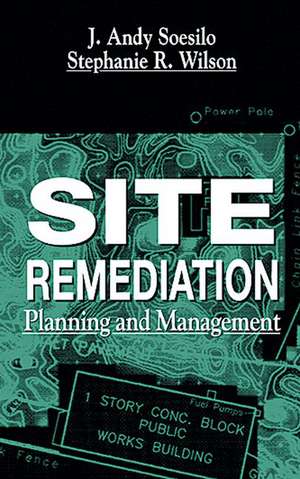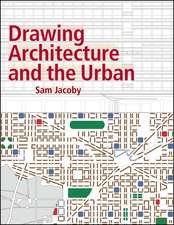Site Remediation
Autor J. Andy Soesilo, Stephanie R. Wilsonen Limba Engleză Hardback – 31 dec 1996
Preț: 1040.85 lei
Preț vechi: 1143.80 lei
-9% Nou
Puncte Express: 1561
Preț estimativ în valută:
199.16€ • 208.50$ • 164.80£
199.16€ • 208.50$ • 164.80£
Carte disponibilă
Livrare economică 17-31 martie
Livrare express 28 februarie-06 martie pentru 41.74 lei
Preluare comenzi: 021 569.72.76
Specificații
ISBN-13: 9781566702072
ISBN-10: 1566702070
Pagini: 432
Ilustrații: 28 tables and 8 halftones
Dimensiuni: 163 x 241 x 40 mm
Greutate: 0.77 kg
Ediția:1
Editura: CRC Press
ISBN-10: 1566702070
Pagini: 432
Ilustrații: 28 tables and 8 halftones
Dimensiuni: 163 x 241 x 40 mm
Greutate: 0.77 kg
Ediția:1
Editura: CRC Press
Public țintă
- Site remediation managers and consultants
- Environmental engineers
- Geological engineers
- Environmental activists
- Government officials
- Students of Environmental Planning and Public Policy
Cuprins
PART I: INTRODUCTION
Planning Issues in Site Remediation
Diverse Regulatory Umbrella
How Clean is Clean?
Uncertainty of Science
Liability and Equity
Urban Revitalization Connection
Components of Site Remediation Planning
Planning Context
The of Remedial Planning
References for Part I
PART II: LEGAL BACKGROUND
Superfund Program
Program Objectives and Operating Mechanism
Superfund Primary Attributes
Implementing Superfund
Relationship with Hazardous Waste Programs
Site Remediation Under RCRA
Basic RCRA Provisions
RCRA Cleanup Program
Leaking UST and PCS Remediation
Objectives of the UST Program
Program Requirements
Closing A Tank
Releases From the Tank and Corrective Action Requirement
Reporting and Recordkeeping
Petroleum-Contaminated Soil
References for Part II
PART III: SITE ASSESSMENT PLANNING
Introduction to SAP and RAP
Contaminant Chemistry
Basic Statistics
Geology and Hydrogeology
Environmental Sampling
Requirements for Achieving Quality Sampling
Assuring the Quality of Sampling Data
Sampling Plan Development
Health and Safety Plan
Sampling Management Issues
Site Characterization
Geophysical Survey
Hydrogeological and Geochemical Investigation
Movement and Fate of Contaminants
Risk Assessment and Management
Human Health Risk Assessment
Risk Management
Ecological Risk
Remediation Standards
Limits of Detection
Background Remediation
Regulatory Cleanup Level
Human Health Risk Standard
Technology-Based Cleanup
References for Part III
PART IV: REMEDIATION ACTION PLANNING
Remediation Technology
Biological Treatment
Physico-Chemical Treatment
Thermal Treatment
Other Technology
Technology Screening and Data Requirements
Screening of Remediation Technologies
Site-Specific Data Requirements
Public Participation
Fundamentals of Environmental Communications
Strategizing Community Relations
Developing Public Participation Plan
Risk Communication in Public Participation Planning
Assistance in Developing Public Participation Planning
References for Part IV
PART V: CONCLUSION
Trends in Site Remediation
The Brownfields Program
The Demand of Remediation Technologies
The Streamlining and Focusing of Site Remediation
References for Part V
Index
Planning Issues in Site Remediation
Diverse Regulatory Umbrella
How Clean is Clean?
Uncertainty of Science
Liability and Equity
Urban Revitalization Connection
Components of Site Remediation Planning
Planning Context
The of Remedial Planning
References for Part I
PART II: LEGAL BACKGROUND
Superfund Program
Program Objectives and Operating Mechanism
Superfund Primary Attributes
Implementing Superfund
Relationship with Hazardous Waste Programs
Site Remediation Under RCRA
Basic RCRA Provisions
RCRA Cleanup Program
Leaking UST and PCS Remediation
Objectives of the UST Program
Program Requirements
Closing A Tank
Releases From the Tank and Corrective Action Requirement
Reporting and Recordkeeping
Petroleum-Contaminated Soil
References for Part II
PART III: SITE ASSESSMENT PLANNING
Introduction to SAP and RAP
Contaminant Chemistry
Basic Statistics
Geology and Hydrogeology
Environmental Sampling
Requirements for Achieving Quality Sampling
Assuring the Quality of Sampling Data
Sampling Plan Development
Health and Safety Plan
Sampling Management Issues
Site Characterization
Geophysical Survey
Hydrogeological and Geochemical Investigation
Movement and Fate of Contaminants
Risk Assessment and Management
Human Health Risk Assessment
Risk Management
Ecological Risk
Remediation Standards
Limits of Detection
Background Remediation
Regulatory Cleanup Level
Human Health Risk Standard
Technology-Based Cleanup
References for Part III
PART IV: REMEDIATION ACTION PLANNING
Remediation Technology
Biological Treatment
Physico-Chemical Treatment
Thermal Treatment
Other Technology
Technology Screening and Data Requirements
Screening of Remediation Technologies
Site-Specific Data Requirements
Public Participation
Fundamentals of Environmental Communications
Strategizing Community Relations
Developing Public Participation Plan
Risk Communication in Public Participation Planning
Assistance in Developing Public Participation Planning
References for Part IV
PART V: CONCLUSION
Trends in Site Remediation
The Brownfields Program
The Demand of Remediation Technologies
The Streamlining and Focusing of Site Remediation
References for Part V
Index
Textul de pe ultima copertă
Site Remediation Planning and Management describes the management of remediation from a planning perspective, skillfully combining Superfund requirements and site remediation strategy in one practical volume. It clarifies and suggests remedies for the current quagmire of confusing Superfund reform and slow, expensive site remediation by thoroughly explaining the Superfund program and then describing how each of its components can fit into an integrated planning and management strategy. Features: a comprehensive approach to site remediation that allows you to quickly grasp its nature and scope; detailed discussions of the site assessment planning process that helps you understand this complex process; thorough reviews of remediation technology that tell you what's available and how to choose effectively; and identification of issues, problems, and trends that orient you to the current and future directions of site remediation.







